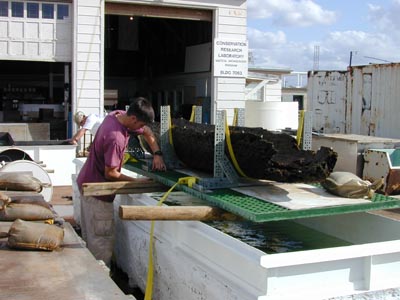CRL Reports: Old Hickory Lake Dugout Canoe

In 1998, R. Christopher Goodwin & Associates contracted the Conservation Research Laboratory at Texas A&M University to conserve the waterlogged remains of a dugout canoe. The canoe was found by U.S. Army Corps of Engineers personnel at Old Hickory Lake near Nashville, Tennessee. Upon initial recovery, the canoe was allowed to dry out, but it was later placed in a container of water and ethanol for rehydration. Fortunately, no serious warping or collapse of the wood is apparent, although it is likely that damage to the cellular structure of the wood did occur.
The canoe was sent to CRL in July 1998 and was subsequently stored in a vat of water. Due to the fragile state of the wood, it has been extremely important to keep the canoe wet at all times.
A complete set of photographs (color and black & white) was taken of the canoe. Detailed drawings, including a three-dimensional AutoCad image, were made by students Adam Kane and Peter Fix. The drawing at left shows profiles, plan views and sections of the vessel. Visible tool marks were also carefully recorded.

The wood has been considerably damaged by erosion and insects. One side of the canoe was especially weakened, so a cradling frame was designed to support the vessel during conservation and transportation. In this way, the canoe can be picked up using the cradle rather than through direct handling. The canoe will stay in the cradle throughout the conservation process and it will be used as a shipping container.
Dendrochronological samples were taken of the canoe to allow accurate dating. Samples for wood species identification have also been taken.


The canoe now sits in a vat undergoing conservation treatment with polyethylene glycol (PEG). The estimated treatment time is two to three years; however, this is subject to the ability of the wood to absorb the PEG. This in turn is dependent on a number of variables, such as the porosity of the wood and the degree of waterlogging.
Citation Information:
Donny L. Hamilton
2002, Conserving a Dugout Canoe, Conservation Research Laboratory Research Report #14, World Wide Web, URL, https://liberalarts.tamu.edu/nautarch/reportlist/old-hickory-lake-dugout-canoe/, Nautical Archaeology Program, Texas A&M University.
